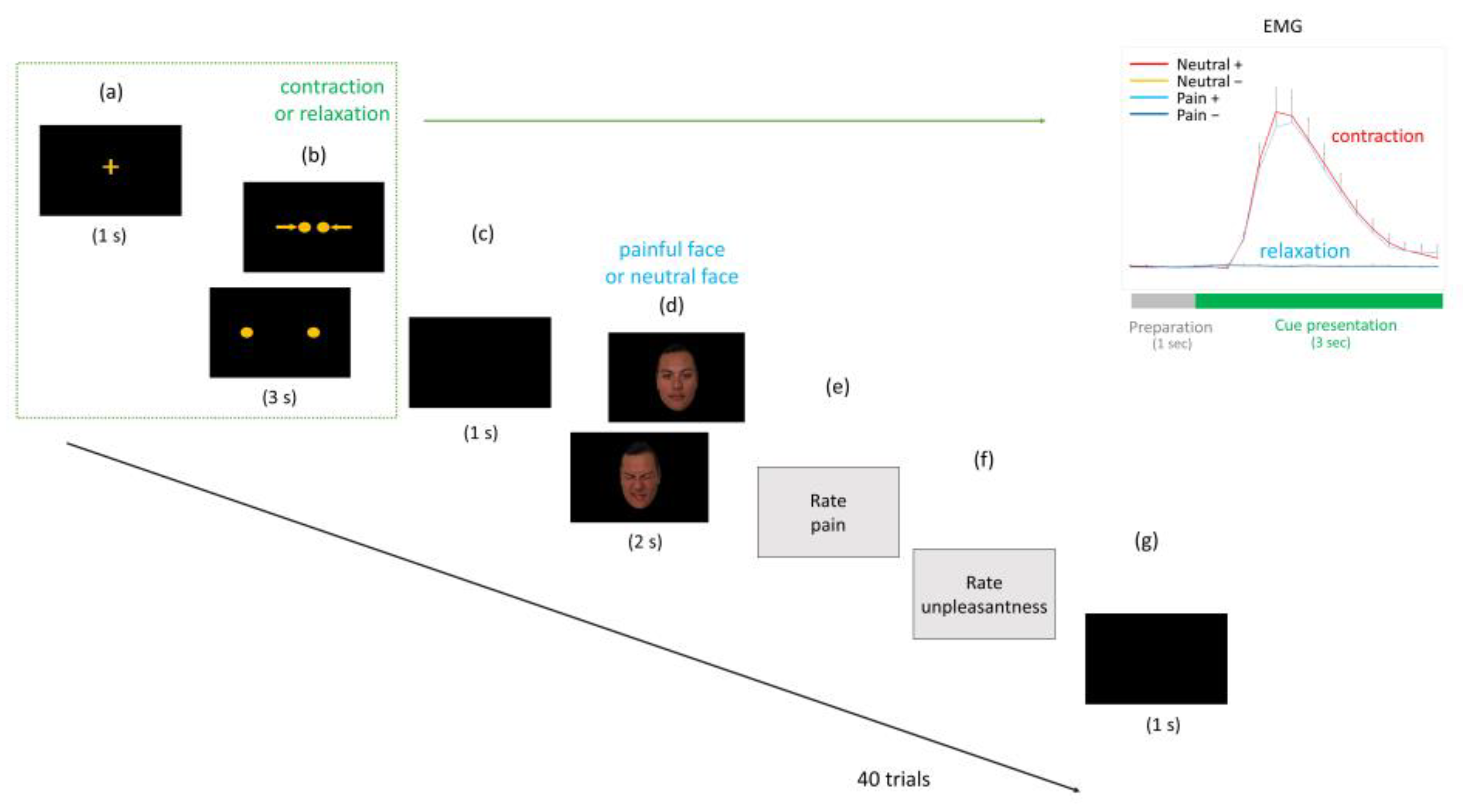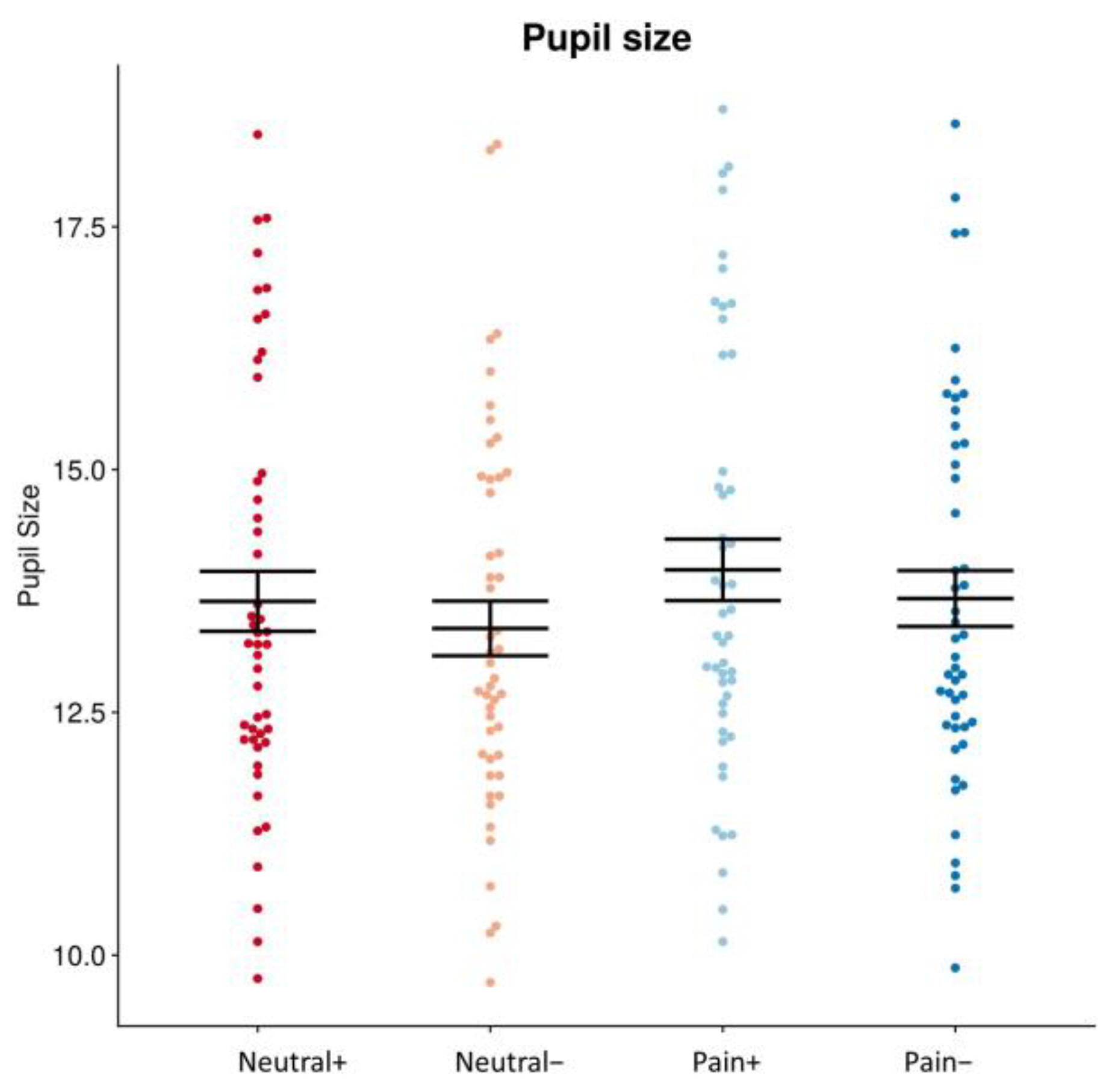Enhanced Empathic Pain by Facial Feedback
Abstract
:1. Introduction
2. Methods
2.1. Participants
2.2. Experimental Design and Procedures
2.3. Facial Electromyogram and Pupil Size Measurements
2.4. Data Analysis
3. Results
3.1. Pain and Unpleasantness Rating
3.2. Pupil Size Changes
4. Discussion
5. Conclusions
Author Contributions
Funding
Institutional Review Board Statement
Informed Consent Statement
Data Availability Statement
Acknowledgments
Conflicts of Interest
References
- Decety, J.; Lamm, C. Human empathy through the lens of social neuroscience. Sci. World J. 2006, 6, 1146–1163. [Google Scholar] [CrossRef] [PubMed]
- Cuff, B.; Brown, S.; Taylor, L.; Howat, D. Empathy: A review of the concept. Emot. Rev. 2016, 8, 144–153. [Google Scholar] [CrossRef]
- Blair, R.J. Responding to the emotions of others: Dissociating forms of empathy through the study of typical and psychiatric populations. Conscious. Cogn. 2005, 14, 698–718. [Google Scholar] [CrossRef]
- Reniers, R.L.; Corcoran, R.; Drake, R.; Shryane, N.M.; Vollm, B.A. The QCAE: A Questionnaire of Cognitive and Affective Empathy. J. Pers. Assess. 2011, 93, 84–95. [Google Scholar] [CrossRef] [PubMed]
- Clark, M.; Robertson, M.; Young, S. “I feel your pain”: A critical review of organizational research on empathy. J. Organ. Behav. 2018, 40, 166–192. [Google Scholar] [CrossRef]
- Zhang, H.B.; Ou, H.; Meng, D.H.; Lu, Q.; Zhang, L.; Lu, X.; Yin, Z.F.; He, C.; Shen, Y. Impaired Cognitive Empathy in Outpatients with Chronic Musculoskeletal Pain: A Cross-Sectional Study. Neural Plast. 2021, 2021, 4430594. [Google Scholar] [CrossRef]
- Alam, M.; Barrett, K.C.; Hodapp, R.M.; Arndt, K.A. Botulinum toxin and the facial feedback hypothesis: Can looking better make you feel happier? J. Am. Acad. Dermatol. 2008, 58, 1061–1072. [Google Scholar] [CrossRef]
- Behera, S.; Rangaiah, B. Identificaton of emotional maturity among traditional dancers: As a function of dance style, gender and residency. Int. J. Indian Psychol. 2016, 3, 108. [Google Scholar]
- McIntosh, D.N. Facial feedback hypotheses: Evidence, implications, and directions. Motiv. Emot. 1996, 20, 121–147. [Google Scholar] [CrossRef]
- Adelmann, P.K.; Zajonc, R.B. Facial efference and the experience of emotion. Annu. Rev. Psychol. 1989, 40, 249–280. [Google Scholar] [CrossRef]
- Meeten, F.; Ivak, P.; Dash, S.; Knwoles, S.; Duka, T.; Scott, R.; Kaiser, J.; Davey, G. The effect of facial expressions on the evaluation of ambiguous statements. J. Exp. Psychol. 2015, 6, 253–263. [Google Scholar] [CrossRef]
- Lanzetta, J.T.; Cartwright-Smith, J.; Kleck, R.E. Effects of nonverbal dissimulation on emotional experience and autonomic arousal. J. Pers. Soc. Psychol. 1976, 33, 354–370. [Google Scholar] [CrossRef] [PubMed]
- Tourangeau, R.; Ellsworth, P.C. The role of facial response in the experience of emotion. J. Pers. Soc. Psychol. 1979, 37, 1519–1531. [Google Scholar] [CrossRef] [PubMed]
- Lee, I.S.; Yoon, S.S.; Lee, S.H.; Lee, H.; Park, H.J.; Wallraven, C.; Chae, Y. An amplification of feedback from facial muscles strengthened sympathetic activations to emotional facial cues. Auton. Neurosci. 2013, 179, 37–42. [Google Scholar] [CrossRef] [PubMed]
- Mende-Siedlecki, P.; Qu-Lee, J.; Lin, J.; Drain, A.; Goharzad, A. The Delaware Pain Database: A set of painful expressions and corresponding norming data. Pain Rep. 2020, 5, e853. [Google Scholar] [CrossRef] [PubMed]
- Huo, T.; Shamay-Tsoory, S.; Han, S. Creative mindset reduces racial ingroup bias in empathic neural responses. Cereb. Cortex 2023, 33, 10558–10574. [Google Scholar] [CrossRef] [PubMed]
- Stelter, M.; Schweinberger, S.R. Understanding the mechanisms underlying the other-‘race’ effect: An attempt at integrating different perspectives. Br. J. Psychol. 2023, 114 (Suppl. S1), 1–9. [Google Scholar] [CrossRef] [PubMed]
- Fridlund, A.J.; Cacioppo, J.T. Guidelines for human electromyographic research. Psychophysiology 1986, 23, 567–589. [Google Scholar] [CrossRef]
- Hsee, C.; Hatfield, E.; Carlson, J.; Chemtob, C. The effect of power on susceptibility to emotional contagion. Cogn. Emot. 1990, 4, 327–340. [Google Scholar] [CrossRef]
- Andreasson, P.; Dimberg, U. Emotional empathy and facial feedback. J. Nonverbal Behav. 2008, 32, 215–224. [Google Scholar] [CrossRef]
- Kunz, M.; Prkachin, K.; Solomon, P.E.; Lautenbacher, S. Faces of clinical pain: Inter-individual facial activity patterns in shoulder pain patients. Eur. J. Pain 2021, 25, 529–540. [Google Scholar] [CrossRef] [PubMed]
- Meister, E.; Horn-Hofmann, C.; Kunz, M.; Krumhuber, E.G.; Lautenbacher, S. Decoding of facial expressions of pain in avatars: Does sex matter? Scand. J. Pain 2021, 21, 174–182. [Google Scholar] [CrossRef] [PubMed]
- Sun, Y.B.; Wang, Y.Z.; Wang, J.Y.; Luo, F. Emotional mimicry signals pain empathy as evidenced by facial electromyography. Sci. Rep. 2015, 5, 16988. [Google Scholar] [CrossRef] [PubMed]
- Pfeifer, M.A.; Cook, D.; Brodsky, J.; Tice, D.; Parrish, D.; Reenan, A.; Halter, J.B.; Porte, D., Jr. Quantitative evaluation of sympathetic and parasympathetic control of iris function. Diabetes Care 1982, 5, 518–528. [Google Scholar] [CrossRef]
- Partala, T.; Surakka, V. Pupil size variation as an indication of affective processing. Int. J. Hum. Comput. Stud. 2003, 59, 185–198. [Google Scholar] [CrossRef]
- Howick, J.; Moscrop, A.; Mebius, A.; Fanshawe, T.R.; Lewith, G.; Bishop, F.L.; Mistiaen, P.; Roberts, N.W.; Dieninyte, E.; Hu, X.Y.; et al. Effects of empathic and positive communication in healthcare consultations: A systematic review and meta-analysis. J. R. Soc. Med. 2018, 111, 240–252. [Google Scholar] [CrossRef]
- Walsh, S.; O’Neill, A.; Hannigan, A.; Harmon, D. Patient-rated physician empathy and patient satisfaction during pain clinic consultations. Ir. J. Med. Sci. 2019, 188, 1379–1384. [Google Scholar] [CrossRef]



Disclaimer/Publisher’s Note: The statements, opinions and data contained in all publications are solely those of the individual author(s) and contributor(s) and not of MDPI and/or the editor(s). MDPI and/or the editor(s) disclaim responsibility for any injury to people or property resulting from any ideas, methods, instructions or products referred to in the content. |
© 2023 by the authors. Licensee MDPI, Basel, Switzerland. This article is an open access article distributed under the terms and conditions of the Creative Commons Attribution (CC BY) license (https://creativecommons.org/licenses/by/4.0/).
Share and Cite
Lee, S.; Yoo, Y.; Moon, H.; Lee, I.-S.; Chae, Y. Enhanced Empathic Pain by Facial Feedback. Brain Sci. 2024, 14, 5. https://doi.org/10.3390/brainsci14010005
Lee S, Yoo Y, Moon H, Lee I-S, Chae Y. Enhanced Empathic Pain by Facial Feedback. Brain Sciences. 2024; 14(1):5. https://doi.org/10.3390/brainsci14010005
Chicago/Turabian StyleLee, Seoyoung, Yeonjoo Yoo, Heeyoung Moon, In-Seon Lee, and Younbyoung Chae. 2024. "Enhanced Empathic Pain by Facial Feedback" Brain Sciences 14, no. 1: 5. https://doi.org/10.3390/brainsci14010005
APA StyleLee, S., Yoo, Y., Moon, H., Lee, I.-S., & Chae, Y. (2024). Enhanced Empathic Pain by Facial Feedback. Brain Sciences, 14(1), 5. https://doi.org/10.3390/brainsci14010005





